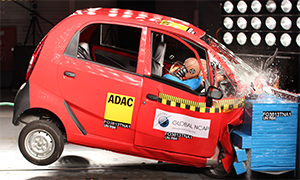 In most developed countries, you might have a good sense of how safe your new vehicle is. Or at least you will be able to access information on safety standards and independent crash test results at the time of purchase. But if you live in a developing country this information either does not exist or is not readily available.
In most developed countries, you might have a good sense of how safe your new vehicle is. Or at least you will be able to access information on safety standards and independent crash test results at the time of purchase. But if you live in a developing country this information either does not exist or is not readily available.
Few consumers in developing countries are aware of the standard safety features in vehicles, and in most cases, the government has failed to mandate the minimum crashworthiness safety standards as recommended by the UN. But the situation is starting to change, and it is exciting to see some progress since the last time I wrote about this important topic. In that blog, I had mentioned how the New Car Assessment Program (NCAP) in Latin America highlighted the fact that new cars sold in that region were 20 years behind in safety technology compared to similar models sold in the US and the European Union.
Earlier this year in New Delhi, the Global New Car Assessment Program, a consumer-awareness non-profit, presented for the first time independent consumer crash test results for five of India’s most popular small cars. Besides increasing awareness among Indians about safety performance of the cars they buy, the event also explored how regulatory standards, in combination with consumer information and incentives, can create a ‘market for safer vehicles’ in the rapidly motorizing nations of the developing world.
The event, organized by Global NCAP and cosponsored by the World Bank-led Global Road Safety Facility, revealed that most small cars sold by global brands in India, including Volkswagen, Hyundai, Suzuki-Maruti, Ford, and Tata, all received zero star rating for adult occupant protection in standard frontal crash tests at 64 kilometers per hour. The optimum is a five-star rating. Indeed, four of the five cars even failed to pass the minimum UN standard (crash test at 56 km/h) which is the bare minimum compliance in most developed countries. On real roads, victims of these crashes would have sustained life-threatening injuries, which could have been avoided had the same cars been rated to the highest safety standards.
The results from these tests probably did not surprise the car makers as they have the safety features and technical know-how to not only meet but even exceed the regulatory standard. Car buyers in India, on the other hand, are blind-sided by marketing targeted at style, comfort and fuel-savings, but with no mention of safety performance.
A market for safer vehicles is indeed crucial in a country like India, which has the highest number of road fatalities in the world. Of the 1.3 million people who lose their lives each year on the world’s roads, more than one in ten will be on Indian roads. Road traffic injuries and deaths are also estimated to cost between 2 and 5 per cent of GDP per year in some developing economies. India also ranks sixth in the world for the production and sale of passenger cars and could become the world’s third largest market by 2020 - emerging as an important global hub for small car production.
But unlike other major car producing nations, it is clear that India does not yet require its vehicles to meet the United Nation’s minimum crash test standards occupant protection in frontal collision and lateral collision – and does not have a New Car Assessment Program (NCAP) that can provide consumers with independent reports on vehicles’ crash safety. The public release of crash data at this event was an eye-opener for Indian consumers to be more aware and conscious about the safety features of their cars, which could be a matter of life and death if encountered with an unfortunate crash on the road.
“Let us applaud the major step taken today to further protect the lives of millions of people. With one in 10 global road deaths occurring in India, we achieve another milestone towards greater road safety: improving vehicle safety standards,” said World Bank’s Transport Sector Manager for South Asia, Karla Gonzalez, in opening remarks at the event. “This has been one of the most neglected pillars of the Global Plan for Action (on road safety) – so it is really good news that a country like India is taking this issue seriously.”
There is no doubt that making road safety a priority is good news for Indian consumers. Let us hope that these first crash test results are only the beginning of a much needed change in behavior at various levels: consumer, auto industry, and government policies.
The World Bank’s Global Road Safety Facility and its various partners stand ready to support these efforts in India and other developing economies where road safety remains a major threat to people’s lives and to sustainable economic growth.
Learn more: Photo credit: Global NCAP


Join the Conversation